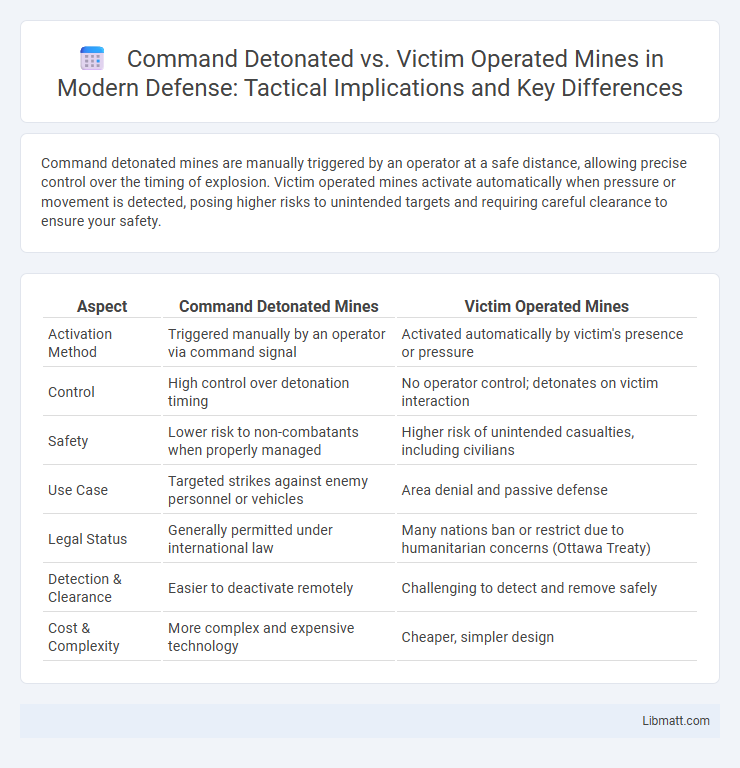Command detonated mines are manually triggered by an operator at a safe distance, allowing precise control over the timing of explosion. Victim operated mines activate automatically when pressure or movement is detected, posing higher risks to unintended targets and requiring careful clearance to ensure your safety.
Table of Comparison
| Aspect | Command Detonated Mines | Victim Operated Mines |
|---|---|---|
| Activation Method | Triggered manually by an operator via command signal | Activated automatically by victim's presence or pressure |
| Control | High control over detonation timing | No operator control; detonates on victim interaction |
| Safety | Lower risk to non-combatants when properly managed | Higher risk of unintended casualties, including civilians |
| Use Case | Targeted strikes against enemy personnel or vehicles | Area denial and passive defense |
| Legal Status | Generally permitted under international law | Many nations ban or restrict due to humanitarian concerns (Ottawa Treaty) |
| Detection & Clearance | Easier to deactivate remotely | Challenging to detect and remove safely |
| Cost & Complexity | More complex and expensive technology | Cheaper, simpler design |
Introduction to Landmine Detonation Mechanisms
Landmine detonation mechanisms include command detonated and victim-operated types, each designed for specific tactical uses. Command detonated mines are triggered remotely by an operator, allowing precise control over timing and target selection, which enhances battlefield strategy and reduces unintended casualties. Victim-operated mines activate when pressure, tripwire, or other forms of direct contact disturb the device, posing a greater risk to unsuspecting individuals and making area denial effective but hazardous for civilians.
Overview: Command Detonated Mines
Command detonated mines are explosive devices remotely triggered by an operator, allowing precise control over the timing and target of detonation. These mines are often used in military operations to enhance safety and effectiveness, as the operator can choose the optimal moment to strike enemy personnel or vehicles. Unlike victim-operated mines, command detonated mines reduce unintended casualties and collateral damage by eliminating automatic activation.
Overview: Victim Operated Mines
Victim operated mines activate upon pressure or proximity when a person interacts directly with the device, typically triggered by stepping on or handling the mine. These mines are designed to cause harm primarily to individuals rather than vehicles, making them particularly hazardous in civilian areas. Their indiscriminate nature complicates clearance efforts, posing ongoing risks in post-conflict zones.
Technical Differences: Command Detonated vs Victim Operated
Command detonated mines are triggered remotely by an operator using a control device, allowing precise timing and minimizing unintended casualties. Victim operated mines activate automatically upon contact or pressure from a person or vehicle, relying on mechanical triggers such as pressure plates or tripwires. Understanding these technical differences helps you assess the risks and deployment strategies associated with each type of mine.
Historical Usage and Evolution
Command detonated mines date back to World War I, where operators manually triggered explosives to control the timing and target. Victim-operated mines gained prominence during World War II as pressure- or tripwire-activated devices designed to inflict casualties without direct intervention. Your understanding of these mines reflects their evolution from controlled battlefield tools to enduring threats that have prompted international humanitarian efforts.
Humanitarian and Civilian Impact
Command detonated mines significantly reduce civilian casualties by allowing controlled activation only when a combatant triggers the device, thus minimizing accidental harm to non-combatants. Victim operated mines pose severe humanitarian risks as they detonate upon contact, indiscriminately injuring or killing civilians, including children, long after conflicts end. Your awareness of these distinctions is crucial for understanding the long-term social and medical burdens caused by landmine contamination in affected communities.
Military Advantages and Tactical Considerations
Command detonated mines offer precise control over detonation timing and target selection, reducing the risk to non-combatants and friendly forces while enabling coordinated, deliberate strikes. Victim operated mines provide area denial and sustained defensive capabilities, disrupting enemy movement and forcing caution but pose a higher risk of unintended casualties and require careful placement to avoid friendly troop injuries. Military strategy often balances the controlled effectiveness of command detonation with the persistent threat enforcement of victim operated mines, optimizing battlefield control and force protection.
Detection and Clearance Challenges
Command detonated mines are easier to detect and clear since they remain inert until manually triggered, allowing deminers to identify and neutralize them with visual cues or signal intercept equipment. Victim-operated mines pose greater clearance challenges because they are pressure, tripwire, or proximity activated, making accidental detonation a constant risk during detection efforts. Your safety in mine clearance operations heavily depends on understanding these differences and employing tailored detection technologies like ground-penetrating radar and explosive-sniffing dogs.
International Law and Policy Implications
Command detonated mines require manual activation, allowing control over timing and target, reducing unintended casualties under international law protocols. Victim operated mines trigger automatically upon contact, raising significant humanitarian concerns and often violating treaties like the Ottawa Convention due to indiscriminate harm to civilians. Understanding these distinctions helps ensure Your adherence to international policy frameworks aimed at minimizing civilian risks and promoting compliance with global mine ban standards.
Future Trends in Landmine Technology
Future trends in landmine technology emphasize smart, command-detonated systems that utilize remote control, sensor integration, and real-time data transmission for precise targeting and reduced collateral damage compared to traditional victim-operated mines. Advances in AI and IoT enable command-detonated mines to distinguish between combatants and civilians, improving compliance with international humanitarian standards. Research prioritizes developing self-deactivating mechanisms and enhanced detection avoidance features to address both effectiveness and post-conflict clearance challenges.
command detonated vs victim operated (mines) Infographic

 libmatt.com
libmatt.com